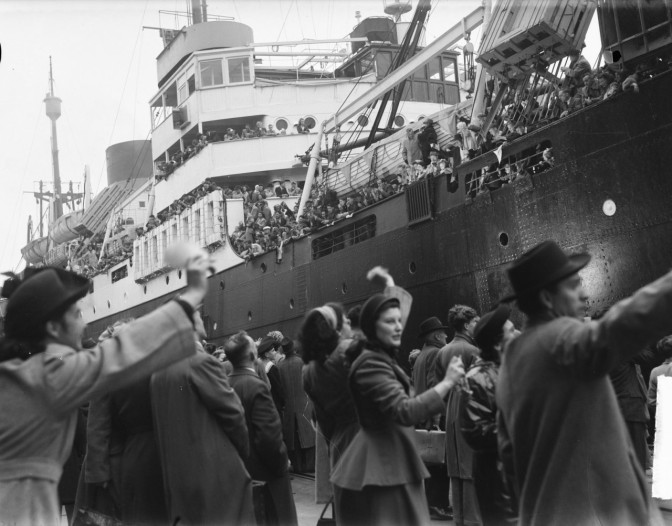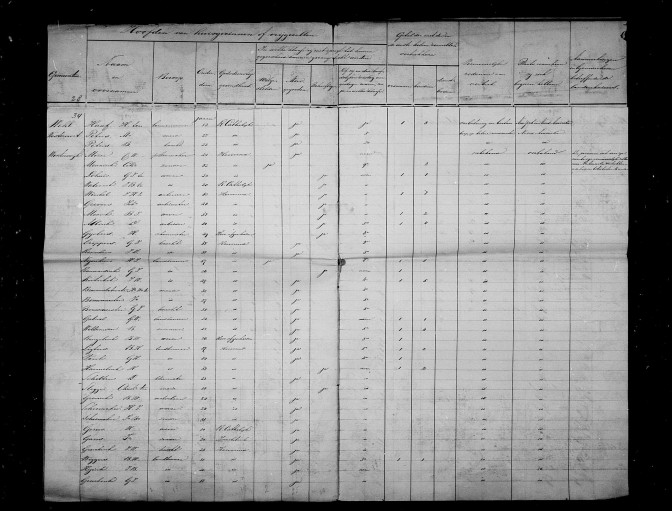In the 1840s, when religious tensions were high and crops were failing, many people left the Netherlands to start a new life in America. The national government wanted to know what was going on. Since 1848, they required each province to keep lists of emigrants, the “Staten van Landverhuizers” [tables of emigrants]. Between 1831 and 1847, only numbers were recorded, but since 1848 the heads of households were listed.
Contents of the Staten van Landverhuizers
The provincial lists were compiled each year. For each municipality, it lists the following information for heads of households or single persons who emigrated:
- Full name
- Occupation
- Date of birth or age
- Religion
- Social status
- The tax bracket they were paying
- The number of men, women and children in the household
- The destination
- The reason for emigration
Example: Derk Abbink, 1854
This image shows a page from the 1854 lists of emigrants from Gelderland, showing several people who left Winterswijk. One entry is for D. Abbink, a 50-year-old Dutch Reformed laborer, who emigrated with his wife and four children. He was a poor man, who paid taxes in the 3rd class. His destination and reason for emigrating are unknown, but a note in the margin says that all these people who left Winterswijk probably went to North America to improve their circumstances.
Creation of the lists
The lists were created by the municipality based on the population registers. People were required to report their departure with the municipality, but from my own emigration research I know that about 1 in 4 failed to register their departure. As soon as the municipality discovered they were gone, they would be stricken from the population register and would be tallied for the emigration list of that year, even though they may have left the previous year or even longer ago.
As much of the data on the emigration lists is derived from the population registers, I always recommend searching the population registers for the period of the emigration. This often provides more information, such as an exact date of departure, or the exact address where the ancestor lived. You will also see the composition of the household he departed from: was he a farm hand who left with the family he worked for? Did he leave at the same time as the neighbors? Knowing the associates may help you trace the migration path of your emigrant ancestor.

Departure of an emigrant ship. Credits: Steenkamp, collection Nationaal Archief
Where to find the lists
The lists were compiled by the provinces, who kept one copy themselves, where they can usually be found in the provincial administration in the archive in the capital of the province. Another copy was sent to Statistics department of the Ministery of Domestic Affairs. These records are kept at the National Archives in The Hague. They can be consulted on microfiche in the reading room of the Central Bureau for Genealogy, next door to the National Archives. Only the period up to 1878 survives in that series, although you may find more complete lists in the provincial administration.
National Archives lists
The National Archives lists have been digitized and are available online at Familysearch. The National Archives made an index available as ‘open data’.
Provincial lists
Some provincial lists are available online:
- For Groningen, scans of the lists are available at AlleGroningers. You will have to browse them manually, the scans are unindexed.
- For Overijssel, the index is included in the “Personen” [persons] search engine. Just search for the name you’re looking for and filter on Rol [role] – Emigrant to limit your search to emigrant lists.
- For Zeeland, an index is available at Zeeuwen gezocht. In the drop-down box, select Source – Emigrant to search the Zeeland lists of emigrants. The original records can be consulted at the Zeeuws Archief in Middelburg, images cannot be ordered.
- For Zuid-Holland, the provincial lists survive for the period 1850-1899. An index is available at gahetNA. You can click through to the online finding aid, where you can order scans via ‘scanning on demand.’
For the other provinces, you will have to go to the archives. Most archives have online catalogs and finding aids where you can search their holdings. Search for the term “landverhuizers” to find these lists. If you know of other lists that are available online, please leave a comment and I will update the article.



Yvette,
Thank you for publishing this information. I found both my great grandfathers on the list for Zuid
Holland.
Marion
Yvette, this has oddly pleased me since you first told me about it. People were leaving their homeland because their circumstances were getting increasingly poor, yet they took the time to go and law-abidingly “sign out” of their country.
It just pleases me.
I really enjoy your newsletter. This last newsletter led to another document to add to my tree.
This document was probably staring me in the face the whole time, but I cannot read Dutch so I appreciate the “step by step” directions.
Hello! I have just found your website and appreciate the information you have compiled. I have only sketchy information about my great-great-grandparents, who emigrated from Holland sometime before 1873. I have been told that my great-great-grandfather was a jeweler, so I’m hoping that will be a good clue! Would that have been a fairly uncommon profession in the mid-1800’s?
Thank you!
Toni